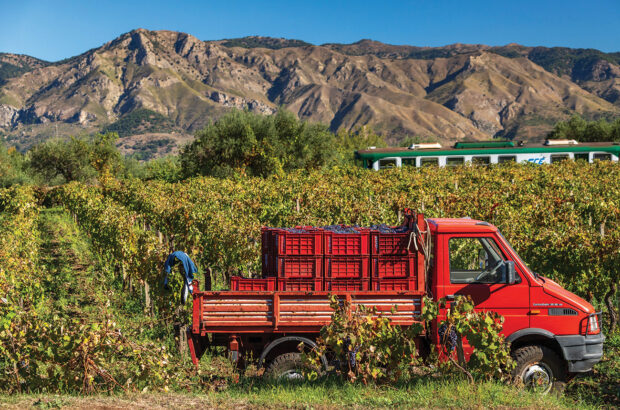The oldest grape varieties in South America have been sidelined for the past hundred years, but a new generation is now reclaiming its lost winemaking heritage as Criolla varieties re-emerge from the shadows. Amanda Barnes has the inside story...
When the Spanish first conquered the Americas in the 1500s, they brought the holy trinity of cultivars – olive trees, wheat and grapevines. Whether planted as sticks or seeds, the first grapes to grow were known as the Criolla, or Mission, varieties: a select handful of varieties picked for their highyielding and resilient nature, and destined to conquer the New World.
Of these founding varieties, which included Moscatel, Pedro Ximénez and Torontel, the most important was a red grape commonly known as Listán Prieto in Spain, Mission in the US, País in Chile, Criolla Chica in Argentina and some 45 other synonyms in-between.
Scroll down for Barnes’ top 10 South American Criolla wines to try
{"content":"PHA+VGhlIGZvdW5kYXRpb25zIG9mIFNvdXRoIEFtZXJpY2HigJlzIHdpbmUgaW5kdXN0cnkgd2VyZSBidWlsdCBvbiB0aGVzZSBlYXJseSBDcmlvbGxhIHZhcmlldGllcyBhcyB2aXRpY3VsdHVyZSBzcHJlYWQgdXB3YXJkcyBmcm9tIE1leGljbyB0byB0aGUgVVMsIGFuZCBzb3V0aHdhcmRzIHRvIFBlcnUsIENoaWxlLCBCb2xpdmlhLCBBcmdlbnRpbmEgYW5kIGJleW9uZC4gQ3Jvc3NlcyBzcGF3bmVkIFNvdXRoIEFtZXJpY2HigJlzIGZpcnN0IG5hdGl2ZSBncmFwZSB2YXJpZXRpZXMg4oCTIGluY2x1ZGluZyBBcmdlbnRpbmHigJlzIFRvcnJvbnTDqXMg4oCTIHdpdGggbW9yZSB0aGFuIDEwMCBDcmlvbGxhIHZhcmlldGllcyBpZGVudGlmaWVkIGluIFNvdXRoIEFtZXJpY2EgdG9kYXkuPC9wPgo8aDI+Rm9yZ290dGVuIHBhdHJpbW9ueTwvaDI+CjxwPkluIHRoZSBtaWQtMTgwMHMgdGhlIGZpcnN0IEZyZW5jaCB2YXJpZXRpZXMgYXJyaXZlZCBvbiB0aGUgY29udGluZW50IGFuZCBwbGFudGF0aW9ucyBvZiBDcmlvbGxhIHZhcmlldGllcyBoYXZlIGJlZW4gaW4gZGVjbGluZSBldmVyIHNpbmNlLCByZXBsYWNlZCBieSBpbnRlcm5hdGlvbmFsIHZhcmlldGllcyBvciByZWxlZ2F0ZWQgdG8gYnVsayB3aW5lLCBqdWljZSBhbmQgdGFibGUgZ3JhcGUgcHJvZHVjdGlvbi48L3A+CjxwPjxkaXYgY2xhc3M9ImFkLWNvbnRhaW5lciBhZC1jb250YWluZXItLW1vYmlsZSI+PGRpdiBpZD0icG9zdC1pbmxpbmUtMiIgY2xhc3M9ImlwYy1hZHZlcnQiPjwvZGl2PjwvZGl2PjwvcD4KPGRpdiBjbGFzcz0iYnJlYWtvdXQgcGFsZXR0ZS1hIHBhbmVsIHBhbmVsLWRlZmF1bHQiPjxkaXYgY2xhc3M9InBhbmVsLWJvZHkiPjxkaXYgY2xhc3M9J2JyZWFrb3V0LWNvbnRlbnQnPjwvcD4KPGgyPkNyaW9sbGE6IHdoYXQgZG9lcyBpdCBtZWFuPzwvaDI+CjxwPkNyaW9sbGEgKG9yIENyaW9sbG8gaW4gbWFzY3VsaW5lIGZvcm0pIGlzIGEgdGVybSB0aGF0IHdhcyBjb2luZWQgaW4gdGhlIGNvbG9uaWFsIGVyYSBmb3IgcGVvcGxlLCBhbmltYWxzIG9yIHBsYW50cyBvZiBTcGFuaXNoIChvciBzb21ldGltZXMgRXVyb3BlYW4pIGRlc2NlbnQsIGRldmVsb3BlZCBvciBib3JuIGluIExhdGluIEFtZXJpY2EuPC9wPgo8cD5BbW9uZyBpdHMgbWFueSBvdGhlciBtZWFuaW5ncywgQ3Jpb2xsYSBpcyB1c2VkIHRvIHJlZmVyIHRvIGEgc2V0IG9mIGdyYXBlIHZhcmlldGllcyB0aGF0IHdlcmUgYnJvdWdodCBmcm9tIFNwYWluIGFuZCBwbGFudGVkIGluIHRoZSBBbWVyaWNhcyBkdXJpbmcgdGhlIGNvbG9uaXNhdGlvbi4gQ3Jpb2xsYSB2YXJpZXRpZXMgdG9kYXkgYWxzbyBpbmNsdWRlIGFuIGV4dGVuc2l2ZSBmYW1pbHkgb2YgY3Jvc3NpbmdzIGJldHdlZW4gdGhlc2Ugb3JpZ2luYWwgdmFyaWV0aWVzLjwvcD4KPGRpdiBjbGFzcz0iYWQtY29udGFpbmVyIGFkLWNvbnRhaW5lci0tbW9iaWxlIj4KPGRpdiBpZD0icG9zdC1pbmxpbmUtMyIgY2xhc3M9ImlwYy1hZHZlcnQiPjwvZGl2Pgo8L2Rpdj4KPHA+CjwvZGl2PjxkaXYgY2xhc3M9J2JyZWFrb3V0LWJ1dHRvbnMnPjxkaXYgY2xhc3M9J3Jvdyc+PC9kaXY+PC9kaXY+PC9kaXY+PC9kaXY+CjxwPkFjY29yZGluZyB0byBhIHN0dWR5IGJ5IHRoZSBVbml2ZXJzaXR5IG9mIFNhbnRpYWdvLCBpbiAxODMzIHRoZSBmaW5lc3QgQ3Jpb2xsYSB2YXJpZXR5LCBMaXN0w6FuIFByaWV0bywgYWNjb3VudGVkIGZvciBtb3JlIHRoYW4gOTAlIG9mIENoaWxl4oCZcyBhbmQgQXJnZW50aW5h4oCZcyB2aW5leWFyZHMuPC9wPgo8ZGl2IGNsYXNzPSJhZC1jb250YWluZXIgYWQtY29udGFpbmVyLS1tb2JpbGUiPjxkaXYgaWQ9InBvc3QtaW5saW5lLTQiIGNsYXNzPSJpcGMtYWR2ZXJ0Ij48L2Rpdj48L2Rpdj4KPHA+VG9kYXkgaXQgaXMganVzdCA3JSBhbmQgMSUgcmVzcGVjdGl2ZWx5LiBJdCwgYW5kIHRoZSBvdGhlciBDcmlvbGxhIHZhcmlldGllcywgaGF2ZSBzaW1pbGFybHkgZmFsbGVuIGludG8gc2V2ZXJlIGRlY2xpbmUgYWNyb3NzIHRoZSByZXN0IG9mIHRoZSBBbWVyaWNhcy48L3A+CjxwPkluY2lkZW50YWxseSwgZm9sbG93aW5nIHBoeWxsb3hlcmEsIExpc3TDoW4gUHJpZXRvIGhhcyBhbGwgYnV0IGRpc2FwcGVhcmVkIGZyb20gaXRzIG5hdGl2ZSBTcGFpbiDigJMgd2l0aCBvbmx5IGEgZG96ZW4gaGVjdGFyZXMgc3Vydml2aW5nIGluIHRoZSBwaHlsbG94ZXJhLWZyZWUgaGF2ZW4gb2YgdGhlIENhbmFyaWVzLjwvcD4KPGRpdiBjbGFzcz0iYWQtY29udGFpbmVyIGFkLWNvbnRhaW5lci0tbW9iaWxlIj48ZGl2IGlkPSJwb3N0LWlubGluZS01IiBjbGFzcz0iaXBjLWFkdmVydCI+PC9kaXY+PC9kaXY+CjxwPlRoZSBvbmx5IHJlbWFpbmluZyBzdHJvbmdob2xkIGZvciBMaXN0w6FuIFByaWV0byBpcyBpbiBDaGlsZSwgd2hlcmUgOSw2MDBoYSBvZiB2aW5lcyAobG9jYWxseSBjYWxsZWQgUGHDrXMpIGNhbiBiZSBmb3VuZCBwaWVjZW1lYWwgaW4gdGhlIHByb3BlcnRpZXMgb2Ygc29tZSA2LDAwMCBncm93ZXJzLCBtb3N0bHkgaW4gdGhlIHNvdXRoZXJuIHJlZ2lvbnMgb2YgTWF1bGUsIEl0YXRhIGFuZCBCw61vIELDrW8uPC9wPgo8cD5JdCBpcyBoZXJlLCB3aGVyZSBncmFwZXMgYXJlIGNoZWFwIGFuZCBsYW5kIHBsZW50aWZ1bCwgdGhhdCByZXBsYW50aW5nIGRpZG7igJl0IGhhcHBlbiB0byB0aGUgc2FtZSBleHRlbnQgYXMgaW4gb3RoZXIgcmVnaW9ucywgbGVhdmluZyBhIHRyZWFzdXJlIHRyb3ZlIG9mIG9sZCB2aW5lcy48L3A+CjxwPk1vc3QgUGHDrXMgdmluZXMgYXJlIG1vcmUgdGhhbiAxMDAgeWVhcnMgb2xkIChwbGFudGVkIGJlZm9yZSB0aGUgbGFuZHNsaWRlIG9mIEZyZW5jaCB2YXJpZXRpZXMpIGFuZCBzb21lIHZpbmV5YXJkcyBkYXRlIGJhY2sgdG8gdGhlIGxhdGUtMTUwMHMg4oCTIGEgZmFjdCB0aGF0IGVuY2hhbnRlZCBhIG5ldyB3YXZlIG9mIHdpbmVtYWtlcnMgY29taW5nIGludG8gQ2hpbGUuPC9wPgo8aDI+PHN0cm9uZz5QaXBlw7FvIHJldml2YWw8L3N0cm9uZz48L2gyPgo8cD5Hcm93ZXJzIG5ldmVyIHN0b3BwZWQgbWFraW5nIHRoZWlyIG93biB3aW5lcyDigJMgdGhlaXIgUGlwZcOxbywgbWFkZSBmcm9tIFBhw61zIG9yIHdoaXRlIENyaW9sbGEgdmFyaWV0aWVzLjwvcD4KPHA+TmFtZWQgYWZ0ZXIgdGhlIGxhcmdlIOKAmHBpcGVz4oCZIChsb2NhbCByYXVsw60gd29vZCBiYXJyZWxzKSB0aGV5IHdlcmUgdmluaWZpZWQgaW4sIFBpcGXDsW8gaXMgc3lub255bW91cyB3aXRoIGFydGlzYW5hbCBtZXRob2RzIGFuZCBwcm9wb3J0aW9ucyBhbmQgaXMgdXN1YWxseSBzb2xkIGZyb20gYSBiYWNrIGRvb3Igb3Igcm9hZHNpZGUsIGFuZCBhbG1vc3QgYWx3YXlzIGJ5IHRoZSBqdWcuPC9wPgo8cD5UcmFkaXRpb24gaGVyZSBkaWRu4oCZdCBkaWUsIGl0IGp1c3QgZ290IHNpZGVsaW5lZC4gQXMgdGhlIEJvcmRlYXV4IGluZmx1ZW5jZSB0b29rIGl0cyBncmlwIG92ZXIgQ2hpbGUgZHVyaW5nIHRoZSBsYXR0ZXIgaGFsZiBvZiB0aGUgMTkwMHMsIFBpcGXDsW8gd2FzIHNodW5uZWQgYXMgYSBwb29yIG1hbuKAmXMgYmV2ZXJhZ2UuPC9wPgo8cD5JbnRlcmVzdGluZ2x5IGl0IGlzIHR3byBmb3JlaWduZXJzIOKAkyB0d28gRnJlbmNoIG1lbiDigJMgd2hvIGhhdmUgYmVlbiBhbW9uZyB0aGUgZ3JlYXRlc3QgYWR2b2NhdGVzIGZvciB0aGUgcmV2aW5kaWNhdGlvbiBvZiBQaXBlw7FvIGFuZCB0aHJ1c3QgaXQgaW50byB0aGUgbGltZWxpZ2h0LjwvcD4KPHA+QnVyZ3VuZHktYnJlZCBMb3Vpcy1BbnRvaW5lIEx1eXQgc3RhcnRlZCB3b3JraW5nIHdpdGggdGhlIHVuZGVyYXBwcmVjaWF0ZWQgY2VudGVuYXJpYW4gUGHDrXMgdmluZXMgaW4gMjAwNy4gTWVudG9yZWQgYnkgTW9yZ29u4oCZcyBncmVhdCBNYXJjZWwgTGFwaWVycmUsIEx1eXQgbWFkZSBpdCBoaXMgbWlzc2lvbiB0byByZWluc3RhdGUgbm90IG9ubHkgdGhlIHZpbmVzIGJ1dCBhbHNvIHRoZSB0cmFkaXRpb25hbCB1c2Ugb2YgemFyYWRhIChhIGJhbWJvbyBkZXN0ZW1tZXIpLCBncmFwZS1zdG9tcGluZyBhbmQgZmVybWVudGF0aW9uIGluIHJhdWzDrSBwaXBlcy48L3A+CjxwPkhpcyB3aW5lcyB3ZXJlIGEgaGl0IGluIEV1cm9wZeKAmXMgbmF0dXJhbCB3aW5lIHNjZW5lLCBvcGVuaW5nIHRoZSBleHBvcnQgbWFya2V0IGFuZCBzZXR0aW5nIGEgYmVuY2htYXJrIGZvciB0aGlzIGxpdHRsZS1rbm93biAoYnV0IHdpZGVseSBncm93bikgdmFyaWV0eS48L3A+CjxwPkFuIGVsZW1lbnQgb2YgY2FyYm9uaWMgbWFjZXJhdGlvbiBpcyBjb21tb24gaW4gTHV5dOKAmXMgd2luZXMsIGFuZCB0aGlzIGxpZ2h0IGFuZCBqdWljeSBkaXJlY3Rpb24gaXMgdGhlIHNhbWUgYXMgdGhhdCB0YWtlbiBieSBhbm90aGVyIEZyZW5jaCBleHBhdCwgRGF2aWQgTWFyY2VsLCBmb3IgaGlzIEF1cGEgUGlwZcOxbyBpbiAyMDEyLjwvcD4KPHA+U29sZCBpbiBiZWVyIGJvdHRsZXMsIEF1cGEgZW1waGFzaXNlZCB0byB0aGUgbG9jYWwgbWFya2V0IHRoYXQgdGhpcyB3aW5lIHNob3VsZCBiZSBkcnVuayB5b3VuZyBhbmQgY2hpbGxlZCDigJMgY2VsZWJyYXRpbmcgUGlwZcOxbyBhcyBDaGlsZeKAmXMgZXF1aXZhbGVudCBvZiBCZWF1am9sYWlzIE5vdXZlYXUuPC9wPgo8cD5UaGUgcmFkaWNhbCByZS1ldmFsdWF0aW9uIG9mIFBpcGXDsW8gaWduaXRlZCBhIHNwYXJrIGluIHRoZSBpbmR1c3RyeSBhbmQgc2V2ZXJhbCB3aW5lbWFrZXJzIGFyZSBkcml2aW5nIGEgZ3Jhc3Mtcm9vdHMgbW92ZW1lbnQgdG8gcmVjbGFpbSB0aGUgcGF0cmltb255IG9mIFBhw61zIGluIHRoZSBzbWFsbGhvbGRpbmdzIG9mIHRoZSBzb3V0aC48L3A+CjxwPkpvc8OpIEx1aXMgR8OzbWV6IEJhc3TDrWFzLCBKdWFuIEpvc8OpIExlZGVzbWEsIExlbyBFcmF6bywgTWFudWVsIE1vcmFnYSBHdXRpw6lycmV6LCBNYXVyaWNpbyBHb256w6FsZXosIFJlbsOhbiBDYW5jaW5vIGFuZCBSb2JlcnRvIEhlbnLDrXF1ZXogYXJlIGF0IHRoZSBmb3JlZnJvbnQgb2YgcHJvZHVjaW5nIGFydGlzYW5hbCwgZ3Jvd2VyIFBhw61zIGFuZCBDcmlvbGxhIHdpbmVzLCBmcm9tIGJvdGggcmVkIGFuZCB3aGl0ZSB2YXJpZXRpZXMuPC9wPgo8aDI+PHN0cm9uZz5UaGUgYmlnZ2VyIHBpY3R1cmU8L3N0cm9uZz48L2gyPgo8cD5QYcOtcyBoYXMgYWx3YXlzIGJlZW4gYSBsYXJnZS1zY2FsZSB2YXJpZXR5IGluIENoaWxlLCBhbmQgdGhlcmUgaGFzIHNpbXVsdGFuZW91c2x5IGJlZW4gYSBzaWduaWZpY2FudCBtb3ZlbWVudCB0byByZWFkb3B0IFBhw61zIGludG8gdGhlIGNvbW1lcmNpYWwgbWFpbnN0cmVhbS48L3A+CjxwPkluIDIwMDYsIFNwYW5pc2ggdmlnbmVyb24gYW5kIENoaWxlIGVudHJlcHJlbmV1ciBNaWd1ZWwgVG9ycmVzIHdhcyBhc2tlZCBieSBDaGlsZeKAmXMgZm9yZWlnbiBhZmZhaXJzIG1pbmlzdGVyIHRvIGxvb2sgaW50byBtYWtpbmcgcXVhbGl0eSB3aW5lIGZyb20gdGhlIHN1cnBsdXMgb2YgUGHDrXMgdmluZXMgaW4gdGhlIHNvdXRoIHRoYXQgd2VyZSBiZWluZyByZXBsYWNlZCBieSBpbmR1c3RyaWFsIGZvcmVzdHMuPC9wPgo8cD5Ub3JyZXPigJkgcHJvcG9zaXRpb24gd2FzIHRvIG1ha2Ugc3BhcmtsaW5nIFBhw61zIHVzaW5nIHRoZSB0cmFkaXRpb25hbCBtZXRob2QsIHNvbWV3aGF0IGFraW4gdG8gQ2F2YSwgZm9yIHdoaWNoIGhlIGhhZCBhIGRlZnQgd2luZW1ha2luZyB0ZWFtIGluIHBsYWNlLjwvcD4KPHA+VG9kYXkgVG9ycmVzIHByb2R1Y2VzIDMwLDAwMCBjYXNlcyBvZiBzcGFya2xpbmcgUGHDrXMgYW5kIGl0cyBGYWlydHJhZGUgcm9zw6kgaXMgdGhlIGJpZ2dlc3Qgc2VsbGluZyBQYcOtcyBpbiB0aGUgd29ybGQuIEJ1dCB0aGUgdGVhbSBhbHNvIGNhbWUgdXAgd2l0aCBhIGxpZ2h0IGFuZCBqdWljeSBjYXJib25pYyBtYWNlcmF0aW9uIHJlZCAoUmVzZXJ2YSBkZSBQdWVibG8pIGFuZCBvdGhlciBtb3JlIGNvbXBsZXggYmxlbmRzLiBGaW5kaW5nIGEgdXNlIGZvciBQYcOtcywgYXMgaXQgdHVybnMgb3V0LCB3YXMgbm90IGFuIGlzc3VlLjwvcD4KPHA+4oCYVGhlIG1ham9yIGNoYWxsZW5nZSBpcyBhY3R1YWxseSBmaW5kaW5nIHZpbmVzIHdpdGggcXVhbGl0eSBwb3RlbnRpYWws4oCZIHNheXMgd2luZW1ha2VyIEZlcm5hbmRvIEFsbWVkYS48L3A+CjxwPuKAmFNsb3BlcyB3aXRoIGdyYW5pdGljIHBvb3Igc29pbCBjb25kaXRpb25zIGFuZCBvY2VhbiBpbmZsdWVuY2UgYXJlIGltcG9ydGFudCwgaW4gb3JkZXIgdG8gZ2V0IGJhbGFuY2VkIHlpZWxkLCBtYWludGFpbiBmcmVzaG5lc3MgYW5kIGFjaGlldmUgcmlwZSB0YW5uaW5zLuKAmTwvcD4KPHA+VGhlIHJlZGlzY292ZXJ5IG9mIFBhw61zIGFsc28gbWFya3MgQ2hpbGXigJlzIGRlcGFydHVyZSBmcm9tIGhpZ2gtb2N0YW5lIHJlZCB3aW5lcyB3aXRoIHJpcGUgZnJ1aXQgY29uY2VudHJhdGlvbiBhbmQgc2lnbmlmaWNhbnQgb2FrIGFnZWluZywgdG93YXJkcyBhIG1vcmUgc2Vuc2l0aXZlIGFwcHJvYWNoLjwvcD4KPHA+4oCYUGHDrXMgaXMgYSBncmVhdCBncmFwZSB0byBncm93IOKAkyBzdXBlci1sb3cgbWFpbnRlbmFuY2Ug4oCTIGJ1dCBQYcOtcyBpcyBub3QgYW4gZWFzeSB3aW5lIHRvIG1ha2UgaW4gdGhlIGNlbGxhcizigJkgZXhwbGFpbnMgRGVyZWsgTW9zc21hbiBLbmFwcCBvZiBHYXJhZ2UgV2luZSBDby4g4oCYSWYgeW91IGFyZSB0b28gcm91Z2gsIGl0IGJlY29tZXMgaGFyc2ggYW5kIHRhbm5pYzsgdG9vIG11Y2ggdGltZSBvbiB0aGUgc2tpbnMgYW5kIGl0IHRpZ2h0ZW5zIHVwIHZlcnkgcXVpY2tseS7igJk8L3A+CjxwPkp1bGlvIEJvdWNob24gU3IsIG9mIEJvdWNob24gRmFtaWx5IFdpbmVzLCBoYWQgYmVlbiBtYWtpbmcgUGHDrXMgZm9yIG1vcmUgdGhhbiAzMCB5ZWFycyB3aXRoIGxpdHRsZSBzYXRpc2ZhY3Rpb24uIOKAmEkgYWRtaXQgSSBkaWQgaXQgYmFkbHkuIEkgd2FudGVkIHRvIG1ha2UgYSBGcmVuY2ggd2luZSDigJMgd2l0aCBjb2xvdXIsIGJvZHkgYW5kIHN0cnVjdHVyZS4gVGhlIHJlc3VsdCB3YXMgYml0dGVyLiBUaGUgbmV3IGdlbmVyYXRpb24gaGF2ZSBtYWRlIHRoZSBzd2l0Y2gu4oCZPC9wPgo8cD5UaGF0IGdlbmVyYXRpb24gaW5jbHVkZXMgaGlzIHNvbiwgSnVsaW8gQm91Y2hvbiBKciwgd2hvIHNheXMsIOKAmFBhw61zIGhhcyBub3RoaW5nIHRvIGRvIHdpdGggdGhlIEJvcmRlYXV4IHdpbmVtYWtpbmcgc3R5bGUuIFdlIGhhdmUgdG8gcmVzcGVjdCB0aGUgZ3JhcGUgd2l0aCBsb3cgaW50ZXJ2ZW50aW9uLuKAmTwvcD4KPHA+Qm91Y2hvbuKAmXMgd2luZW1ha2VyIENocmlzdGlhbiBTZXDDumx2ZWRhIGFkZHM6IOKAmFdlIHRyeSB0byBiZSB2ZXJ5IGdlbnRsZSB3aXRoIHRoZSBleHRyYWN0aW9u4oCmdG8gc2hvdyB0aGF0IFBhw61zIGRvZXNu4oCZdCBoYXZlIHJ1c3RpYyB0YW5uaW5zIOKAkyB0aGUgc3RydWN0dXJlIGlzIGVsZWdhbnQu4oCZIFdpbmVtYWtlcnMgdG9kYXkgYXJlIHRyZWF0aW5nIFBhw61zIGxlc3MgbGlrZSBCb3JkZWF1eCBhbmQgbW9yZSBsaWtlIFBpbm90IE5vaXIuPC9wPgo8aDI+PHN0cm9uZz5Vbml0aW5nIFNvdXRoIEFtZXJpY2E8L3N0cm9uZz48L2gyPgo8cD5UaGVyZSBpcyBhIENyaW9sbGEgcmV2aXZhbCBoYXBwZW5pbmcgb24gdGhlIG90aGVyIHNpZGUgb2YgdGhlIEFuZGVzIHRvbywgYnV0IEFyZ2VudGluYeKAmXMgQ3Jpb2xsYSBnZW5lIHBvb2wgaXMgbW9yZSBkaXZlcnNlLCB3aXRoIGEgZ3JlYXRlciBzcHJlYWQgYW5kIHF1YW50aXR5IG9mIHdoaXRlIGFuZCByZWQgQ3Jpb2xsYSB2YXJpZXRpZXMuPC9wPgo8cD5Tb21lIDc1LDAwMGhhIG9mIHZpbmV5YXJkcyBwbGFudGVkIHdpdGggQ3Jpb2xsYSB2YXJpZXRpZXMgc3Vydml2ZSB0b2RheSwgYWNjb3VudGluZyBmb3IgbW9yZSB0aGFuIGEgdGhpcmQgb2YgdGhlIG5hdGlvbmFsIHRvdGFsIOKAkyBob3dldmVyLCB0aGUgQ3Jpb2xsYSB2YXJpZXRpZXMgYWNjb3VudCBmb3IgbGVzcyB0aGFuIDUlIG9mIEFyZ2VudGluYeKAmXMgdmFyaWV0YWwgb3IgcHJlbWl1bSB3aW5lIHByb2R1Y3Rpb24sIG1haW5seSBhcyBUb3Jyb250w6lzLjwvcD4KPHA+UGFydCBvZiB0aGUgcHJvYmxlbSBpcyB0aGF0IHRoZSBmaW5lc3QgcmVkIENyaW9sbGEgZ3JhcGUsIExpc3TDoW4gUHJpZXRvIChha2EgQ3Jpb2xsYSBDaGljYSksIGhhcyBkd2luZGxlZCB0byBsZXNzIHRoYW4gMzYwaGEgdG9kYXksIHN1cGVyc2VkZWQgYnkgbG93ZXIgcXVhbGl0eSB2YXJpZXRpZXMgc3VjaCBhcyBDZXJlemEuIENyaW9sbGEgdmFyaWV0aWVzIGFyZSByYXJlbHkgcGxhbnRlZCBhcyBzaW5nbGUgdmFyaWV0aWVzLCBtZWFuaW5nIHRoZXkgZWl0aGVyIGhhdmUgdG8gYmUgdmluaWZpZWQgYXMgZmllbGQgYmxlbmRzIG9yIHJlcXVpcmUgY2FyZWZ1bCBzZWxlY3Rpb24gaW4gdGhlIHZpbmV5YXJkcyAodG8gbWFrZSBhIHNpbmdsZS12YXJpZXR5IENyaW9sbGEgd2luZSkuPC9wPgo8cD5TaXRlIHNlbGVjdGlvbiBpcywgaG93ZXZlciwgd2hhdCBpcyBkcml2aW5nIHRoZSBjdXJyZW50IGV4Y2l0ZW1lbnQgYWJvdXQgQ3Jpb2xsYSBpbiBBcmdlbnRpbmEuIOKAmENyaW9sbGEgQ2hpY2EgaXMgYSB2YXJpZXR5IGNhcGFibGUgb2YgZXhwcmVzc2luZyBwbGFjZXMsIGNsaW1hdGVzLCBzb2lscyBhbmQgcGVvcGxlLCB3aGlsZSBtYWludGFpbmluZyBpdHMgcGVyc29uYWxpdHkgaW50YWN0LOKAmSBzYXlzIFNlYmFzdGnDoW4gWnVjY2FyZGksIHdobyBoYXMgYmVlbiBwcm9kdWNpbmcgQ2FyYSBTdXIgQ3Jpb2xsYSBDaGljYSBmcm9tIGhpZ2gtYWx0aXR1ZGUgQmFycmVhbCBzaW5jZSAyMDE0LjwvcD4KPHA+4oCYSXQgaGFzIGdyZWF0IHdpbmVtYWtpbmcgYXR0cmlidXRlcywgbm90IG9ubHkgZm9yIHRoZSBxdWFsaXR5IG9mIHRoZSB3aW5lcyB5b3UgY2FuIG1ha2UsIGJ1dCBhbHNvIGZvciBpdHMgaGlnaCB5aWVsZC7igJk8L3A+CjxwPkhpc3RvcmljYWxseSBDcmlvbGxhIHZhcmlldGllcyB3ZXJlIGZhdm91cmVkIGZvciB0aGVpciBnZW5lcm91cyB5aWVsZCBhbmQgdG9kYXkgd2luZW1ha2VycyBhcmUgZmFsbGluZyBmb3IgdGhlaXIgc2Vuc29yaWFsIGNoYXJtcyB0b28uPC9wPgo8cD7igJhDcmlvbGxhIGdyYXBlcyB5aWVsZCBmb3VyIHRpbWVzIG1vcmUgdGhhbiBhIGZpbmUgZ3JhcGUgd291bGQs4oCZIGV4cGxhaW5zIENhZHVzIHdpbmVtYWtlciBTYW50aWFnbyBNYXlvcmdhLiDigJhUaGV5IHdlcmUgYSBib29uIGluIHRoZSAxOTcwcyB3aGVuIHBlb3BsZSB3ZXJlIGRyaW5raW5nIDkwIGxpdHJlcyBwZXIgY2FwaXRhLjwvcD4KPHA+JiM4MjE2O1RvZGF5IHBlb3BsZSBhcmUgbG9va2luZyBmb3IgcXVhbGl0eSBhbmQgdGVycm9pci1kcml2ZW4gd2luZXMuIFdpdGggcHJlY2lzZSB2aW5pZmljYXRpb24gd2UgY2FuIGFjaGlldmUgYW4gaW50ZXJlc3Rpbmcgd2luZSDigJMgcHVyZSwgc3VidGxlIGFuZCBmcmVzaCB3aXRoIHNvbWUgZWFydGhpbmVzcy7igJk8L3A+CjxwPkFyZ2VudGluYeKAmXMgd2luZW1ha2VycyBhcmUgZW1icmFjaW5nIHRoZSBkaWZmZXJlbnQgZGltZW5zaW9uIENyaW9sbGEgdmFyaWV0aWVzIG9mZmVyIOKAkyBhcyB3aGl0ZSwgcmVkIGFuZCBvcmFuZ2Ugd2luZXMg4oCTIGFkb3B0ZWVzIGFjcm9zcyB0aGUgY291bnRyeSBpbmNsdWRpbmcgQ2FkdXMsIENhcmEgU3VyLCBEdXJpZ3V0dGksIEVsIEVzdGVjbywgRXJuZXN0byBDYXRlbmEsIFBhc28gYSBQYXNvLCBQYXNzaW9uYXRlIFdpbmVzLCBUcml2ZW50byBhbmQgVmFsbGlzdG8uPC9wPgo8cD5DcmlvbGxhIGlzIGFsc28gdGFraW5nIHdpbmVtYWtlcnMgZnVydGhlciBhZmllbGQuIENoaWxl4oCZcyBMdXl0IGlzIHZpbmlmeWluZyBDcmlvbGxhIHZhcmlldGllcyBpbiBNZXhpY28gKEJpY2hpKSBhbmQgaW4gQXJnZW50aW5hLCBNYXTDrWFzIE1pY2hlbGluaSBpcyBtYWtpbmcgYSBDcmlvbGxhIEdyYW5kZSB3aW5lIGluIFVjbyBWYWxsZXkgYW5kIHdvcmtpbmcgd2l0aCBDcmlvbGxhIHZhcmlldGllcyBpbiBQZXJ1IChNaW1vKS48L3A+CjxwPuKAmENyaW9sbGEgW0dyYW5kZV0gaXMgYSBub2JsZSB2YXJpZXR5IHdoaWNoIG1ha2VzIGp1aWN5IGFuZCBmcmVzaCB3aW5lcyzigJkgZW50aHVzZXMgTWljaGVsaW5pLiDigJhJdOKAmXMgYSB2YXJpZXR5IHdlIG5lZWQgdG8gZGV2ZWxvcCDigJMgaXQgY291bGQgYmVjb21lIGltcG9ydGFudCBmb3IgdGhlIHRydWUgY2hhcmFjdGVyIG9mIExhdGluIEFtZXJpY2FuIHdpbmUu4oCZPC9wPgo8aDI+PHN0cm9uZz5UZXN0IG9mIHRpbWU8L3N0cm9uZz48L2gyPgo8cD5BcyBjb25zdW1lcnMgbG9vayBmb3Igd2luZXMgd2l0aCBpZGVudGl0eSwgdGhlIENyaW9sbGEgdmFyaWV0aWVzIG9mZmVyIHRoZSBtb3N0IGF1dGhlbnRpYyBpbnNpZ2h0IGludG8gdGhlIGhpc3Rvcnkgb2YgU291dGggQW1lcmljYW4gdml0aWN1bHR1cmUuIFRoZXkgY291bGQgYWxzbyBob2xkIHRoZSBrZXkgdG8gdGhlIGZ1dHVyZSwgbm90IG9ubHkgaW4gdGhlIGdsYXNzIGJ1dCBpbiB0aGUgZ3JvdW5kIHRvby48L3A+CjxwPkludmVzdG1lbnQgaXMgaGFwcGVuaW5nIGluIGJvdGggcHJpdmF0ZSBhbmQgcHVibGljIHJlc2VhcmNoIGluc3RpdHV0ZXMgaW4gQ2hpbGUgYW5kIEFyZ2VudGluYSwgbWFwcGluZyBvdXQgdGhlIEROQSBvZiBzb21lIENyaW9sbGEgdmFyaWV0aWVzIGFuZCB1c2luZyBzZW5zb3JpYWwgYW5hbHlzaXMgdG8gaWRlbnRpZnkgdGhlIHJlZ2lvbmFsIGV4cHJlc3Npb25zIOKAkyB3aGljaCBoYXZlIGxvbmcgYmVlbiByZWNvZ25pc2VkIGJ5IHRoZSBncm93ZXJzIGFuZCBodW1ibGUgZHJpbmtlcnMgb2YgUGlwZcOxbyB3aW5lcy48L3A+CjxwPlRoZXNlIG9sZCB2aW5lcyBoYXZlIHN0b29kIHRoZSB0ZXN0IG9mIHRpbWUgYmVjYXVzZSB0aGV5IGFyZSBzbyB3ZWxsIGFkYXB0ZWQg4oCTIHRoZSBza2lucyBhcmUgcmVzaXN0YW50LCB0aGUgd29vZCBpcyBoYXJkeSBhbmQgdGhlIHZpbmUgY2FuIHN1cnZpdmUgaW4gZHJvdWdodC48L3A+CjxwPlBhw61zIHJvb3RzdG9ja3MgYXJlIGJlaW5nIGluY3JlYXNpbmdseSBjaG9zZW4gaW4gQ2hpbGUgZm9yIHRoZWlyIHJlc2lzdGFuY2UgdG8gdGhlIG1hcmdhcm9kZXMgc2NhbGUgaW5zZWN0LCBhbmQgc3VpdGFiaWxpdHkgZm9yIGRyeSBmYXJtaW5nLiBHb2luZyBiYWNrIHRvIGl0cyBDcmlvbGxhIHJvb3RzIGNvdWxkIHdlbGwgYmUgU291dGggQW1lcmljYeKAmXMgYmVzdCBvcHRpb24gdG8gZmFjZSB0aGUgY2hhbGxlbmdlcyBvZiBjbGltYXRlIGNoYW5nZS48L3A+CjxwPlRoZSBtb3ZlbWVudCBpcyB1bmRlcndheSwgYnV0IHRoZXJlIGlzIGEgbG9uZyB3YXkgdG8gZ28uIENlbnRlbmFyaWFuIHZpbmVzIGFyZSBiZWluZyB0b3JuIG91dCBhcyBzbWFsbCBncm93ZXJzIHN0cnVnZ2xlIHRvIG1ha2UgZW5kcyBtZWV0IGFuZCBoYXZlIHRvIHNlbGwgZ3JhcGVzIGZvciBidWxrIOKAkyBpbiBNYXVsZSwgUGHDrXMgY2FuIHNlbGwgZm9yIGFzIGxpdHRsZSBhcyDCozAuMDUva2csIGNvbXBhcmVkIHRvIMKjMC40MCBmb3IgPGEgaHJlZj0iaHR0cHM6Ly93d3cuZGVjYW50ZXIuY29tL3dpbmUvZ3JhcGUtdmFyaWV0aWVzL2NhYmVybmV0LXNhdXZpZ25vbi8iIHRhcmdldD0iX2JsYW5rIiByZWw9Im5vb3BlbmVyIj5DYWJlcm5ldCBTYXV2aWdub248L2E+LjwvcD4KPHA+4oCYUGHDrXMgaXMgYSBzb2NpYWwgaXNzdWUg4oCTIGl0IG9ubHkgZXhpc3RzIGxpdmluZyBhbG9uZ3NpZGUgbG9jYWwgcGVvcGxlIGluIHRoZSBjb3VudHJ5c2lkZSzigJkgc2F5cyB3aW5lbWFrZXIgUm9iZXJ0byBIZW5yw61xdWV6LjwvcD4KPGRpdiBjbGFzcz0iaW5qZWN0aW9uIj48L2Rpdj4KPHA+4oCYQSBuZXcgd2luZSBjYW4gYmVjb21lIGEgbmljaGUsIGJ1dCB0aGVyZeKAmXMgYSBsb3Qgb2YgUGHDrXMgcGxhbnRlZCBhbmQgSeKAmW0gbm90IHN1cmUgdGhlIHdvcmxkIGlzIHJlYWR5IHRvIGRyaW5rIHRoYXQgbXVjaCBQYcOtcyEgVGhhdOKAmXMgdGhlIGNoYWxsZW5nZSwgYW5kIG1ha2luZyBzdXJlIGl0IHJlYWxseSBkb2VzIGltcHJvdmUgdGhlIHF1YWxpdHkgb2YgbGlmZSBmb3IgbG9jYWwgZmFybWVycy7igJk8L3A+CjxwPkEgZ3Jvd2luZyBsZWdpb24gb2Ygd2luZW1ha2VycyBpbiBTb3V0aCBBbWVyaWNhIGFyZSBqb2luaW5nIHRoZSBjYXVzZSwgY29udmluY2VkIHRoYXQgQ3Jpb2xsYSB3aW5lcyBhcmUgbm90IG9ubHkgdGhlIHRydWUgaGVyaXRhZ2Ugb2YgU291dGggQW1lcmljYSwgYnV0IHdvcnRoeSBjaGFtcGlvbnMgb2YgaXRzIGZ1dHVyZS4gT25seSB0aW1lIHdpbGwgdGVsbCBpZiB0aGUgbWFya2V0IGNhdGNoZXMgb24gaW4gdGhlIHNhbWUgd2F5IOKAkyBiZWZvcmUgaXTigJlzIHRvbyBsYXRlLjxpPjwvaT48L3A+CjxwPgo="}
See Barnes’ top 10 South American Criolla wines to try
{}
{"wineId":"23992","displayCase":"standard","paywall":true}
{"wineId":"23993","displayCase":"standard","paywall":true}
{"wineId":"23994","displayCase":"standard","paywall":true}
{"wineId":"23995","displayCase":"standard","paywall":true}
{"wineId":"23996","displayCase":"standard","paywall":true}
{"wineId":"23997","displayCase":"standard","paywall":true}
{"wineId":"23998","displayCase":"standard","paywall":true}
{"wineId":"23999","displayCase":"standard","paywall":true}
{"wineId":"24000","displayCase":"standard","paywall":true}
{"wineId":"24001","displayCase":"standard","paywall":true}
{}
You might also like:












